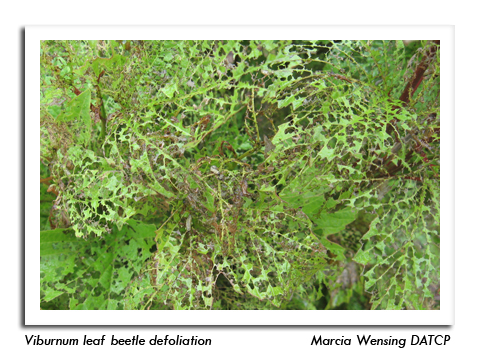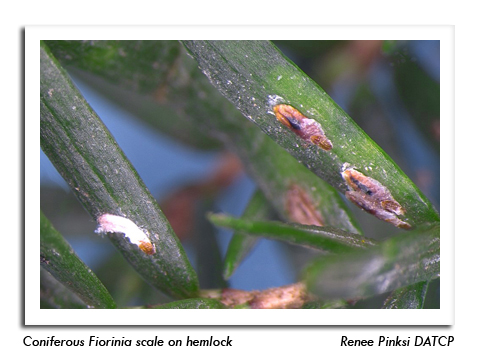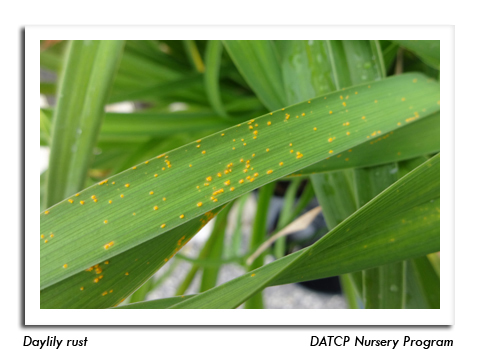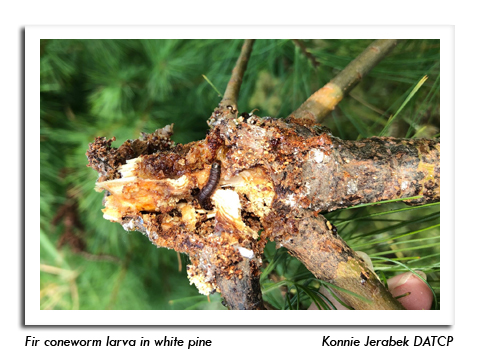
 |
|
|
Nursery & Forest
Volume 65 Number 18 Date 11/12/2020 NURSERY INSPECTION - The Nursery Program licensed 582 nursery growers and 1,175 retailers this year, with staff performing 701 site inspections statewide. Annual inspections are prioritized for out-of-state shippers and those holding a Plant Health Certificate. The top 10 insects and diseases found were, by total number of detections: viruses, rusts, leaf spots, anthracnose, leafminers, aphids, Japanese beetle, powdery mildew, apple scab and spider mites. Summarized below are highlights from the 2020 inspections. LILY LEAF BEETLE - The invasive red lily leaf beetle was documented in eight new counties this season: Brown, Calumet, Clark, Milwaukee, Outagamie, Vernon, Vilas, Waukesha, and Waupaca. First detected in Marathon County in 2014, lily leaf beetle has now been confirmed in 21 Wisconsin counties. Nurseries that grow lilies should become familiar with this beetle's life cycle and how to manage it, and pass the information along to their customers. Overwintered bright red adult beetles will begin feeding on foliage as soon as lilies break through the ground next spring. VIBURNUM LEAF BEETLE - Nursery inspections found 24 cases of viburnum leaf beetle in southeastern Wisconsin in 2020. This recently-established pest feeds exclusively on the leaves of viburnums, and both the adults and larvae cause extreme defoliation and eventual shrub mortality after successive years of infestation. Native viburnums are an important understory component of many Wisconsin woodlands and are at risk. Viburnum leaf beetle has now been found in 11 Wisconsin counties since 2009: Brown, Dane, Iron, Kenosha, Milwaukee, Ozaukee, Racine, Walworth, Washington, Waukesha, and Winnebago. CONIFEROUS FIORINIA SCALE - This nonnative scale pest was detected on hemlock nursery stock imported from the Mid-Atlantic region to southeastern Wisconsin in July. Coniferous Fiorinia scale (Fiorinia japonica) originates in Southeast Asia and had not previously been reported in the state. This insect has the potential to impact native evergreens, including fir, pine, spruce, hemlock, juniper (including red cedar), and Canadian yew. DATCP issued a Pest Abatement Order to prevent this potentially invasive species from becoming established in Wisconsin. NR 40 INVASIVE PLANTS - NR40 invasive plants were found at 46 separate nursery locations this season, down from 69 in 2019. The phase-out period for selling remaining inventory classified as "restricted" ended May 1, 2020. Inspectors issued orders for the invasive plants to be either removed from sale and destroyed or returned to the supplier. DAYLILY RUST - This disease was significantly more prevalent in 2020 than in prior years. Daylily rust is not known to overwinter in Wisconsin, but arrives by spores on southerly winds or on infected plants from out-of-state. Nurseries receiving daylilies infected with rust were allowed to either return the material to the supplier or cut back the foliage and apply a chemical treatment. Daylilies successfully treated could then be sold. -- Liz Meils, DATCP Nursery Inspector PLANT INDUSTRY LAB - As of November 10, the PIB Lab processed 427 nursery samples for plant diseases, nematodes and pest identifications. This decrease from 620 samples in 2019 was inevitable due to lab capacity limitations necessitated by COVID-19 safety guidelines. Results were as follows: GERANIUM WILT - DATCP inspectors participated in the trace-forward investigation and national recall of Ralstonia wilt-infected florist's geraniums 'Fantasia Pink Flare' and 'Fantasia Salmon' from 28 Wisconsin greenhouses. Eighteen samples were screened at the PIB Lab. All tested negative for R. solanacearum. RAMORUM BLIGHT - During routine nursery inspections, staff collected 32 symptomatic plants from 18 locations. The PIB Lab tested five lilacs, one magnolia tree, one pear tree, two pieris plants, 22 rhododendrons and one viburnum. All were negative for Phytophthora ramorum, including seven samples that were infected with Phytophthora blights caused by other Phytophthora species. BOXWOOD BLIGHT - This devastating fungal disease was diagnosed in two boxwood samples from a Milwaukee County residence in April. Sixty-eight other suspect samples collected by inspectors from 22 nurseries and retailers all tested negative this season. In 2019, boxwood blight was found in two Kenosha County nurseries, at two retailers in Dane and Portage counties, and on landscape boxwoods in Dane County. Boxwood blight remains an emerging threat that residents, retailers and the green industry should continue to be alert for. RUSTS ON ORNAMENTALS - Conditions were conducive for many rust diseases in 2020. Gymnosporangium rusts were detected on apple, crabapple, hawthorn, and serviceberry. The striking elderberry rust (Puccinia sambuci) was detected on four occasions. Bracken rust (Uredinopsis pteridis), Eastern leatherwood rust (Puccinia dioicae), hawthorn rust (Puccinia coronata) and pine-oak rust (Cronartium quercuum f.sp.banksianae) were also noted during inspections. NEMATODES - Root knot nematodes (Meloidogyne spp.) were detected on Anemone 'Prince Henry' and Astilbe varieties 'Fanal,' 'Visions in Red,' 'Maggie Daley' and 'Younique Silvery Pink' at two nurseries in Jefferson and Washington counties. The roots, already weakened by the nematode damage, were colonized by fungal pathogens contributing to decay. The fungal pathogens Fusarium, Phytophthora or Pythium and Thielaviopsis were identified on the blackened roots. Foliar nematodes (Aphelenchoides spp.) were detected on anemone, hosta, and sensitive fern. VIRUSES OF ORNAMENTALS - Nursery inspectors collected 125 ornamental samples for virus testing this year. Twenty-three of 24 iris plants tested positive for potyvirus, most likely iris severe mosaic virus. Besides iris, canna (2 plants) and sedum (3 plants) were infected with potyviruses. Tobacco rattle virus (TRV) continued to be a common problem on bleeding heart and many astilbe varieties. TRV was also found on Celandine poppy, hosta, peony and phlox. Co-infections of TRV and a virus in the ilarvirus group, likely tobacco streak virus, occurred on astilbe varieties 'Fanal,' 'Freya,' and 'Red Sentinel.' Single ilarvirus infections were found on astilbe 'Fanal,' 'Maggie Daley,' 'Purple Candles,' and 'Rheinland.' A different ilarvirus, possibly alfalfa mosaic virus, was found infecting pachysandra Other virus finds included two lilacs with lilac leaf chlorosis virus, one clematis with clematis chlorotic mottle virus and one Stokes aster with impatiens necrotic spot virus. -- Anette Phibbs & Sam Fieweger, DATCP Plant Industry Lab GYPSY MOTH - Populations rebounded in 2020 following relatively mild winter and spring conditions. Egg hatch began on May 2 and male moths were first reported on July 8. Pheromone traps deployed mainly across western Wisconsin captured an unofficial total of 83,747 male moths (in 10,131 traps), putting 2020 statewide populations roughly on par with those reported in 2018. The advancing gypsy moth front in the state (10 moth line) moved an average of 5.9 km westward. This was largely driven by spread in the southern and central regions. Both DATCP and the DNR noted an increase in reports of nuisance caterpillars this summer, largely from urban areas in the eastern portion of the quarantine region (Milwaukee, Green Bay, the Fox Valley, and Madison). There were very few scattered reports of defoliation. Currently, 50 of Wisconsin's 72 counties are now under quarantine for gypsy moth. No new counties were added to the quarantine in 2020. -- Michael Falk, DATCP Gypsy Moth Trapping Coordinator SPOTTED LANTERNFLY - DATCP stepped up efforts this year to keep this highly invasive "hitchhiker" out of the state. Fifty-three sites with tree of heaven (Ailanthus altissima), the lanternfly's preferred host, were identified and surveyed for SLF life stages. Tree of heaven (TOH) was found in Dane, Jefferson, Kenosha, Milwaukee, Racine and Rock counties. In Milwaukee County, a limited number of baited circle traps were monitored from August-November. In addition, visual surveys were conducted at 12 vineyards and 18 apple orchards during the growing season. SLF has not been found in Wisconsin. More information about this pest is available at https://youtu.be/wVmuKwreYdU and https://slf.wi.gov EMERALD ASH BORER - Public and state agency reports of emerald ash borer (EAB) infested trees continue to be received and validated by DATCP. In 2020, these reports resulted in six new county detections (Dunn, Florence, Oconto, Pepin, Price and Shawano) and 268 city, town, or village detections within previously confirmed counties. Municipal detections now total 801 and encompass 34% of the state's total acreage. EAB has become widespread across the southern third of the state, while infestations remain more isolated in central and northern areas, despite a noticeable increase in new detections this year. Since 2008, EAB has been confirmed in 58 of Wisconsin's 72 counties. COTTONY ASH PSYLLID - A Wood County homeowner reported this seldom-observed exotic European pest of ash this season. Adult psyllids, also known as jumping plant lice, were found on the main trunk of a 12-year-old Mancana ash in late June, followed by nymphs within twisted and curled foliage by mid-July. This was the second report of cottony ash psyllid in Wisconsin, with the first detection confirmed by UW-Extension in 2006 on samples from St. Croix County. Unlike native foliage pests such as ash plant bug or ash leaf curl aphid that cause mostly cosmetic damage, infestation by this pest over multiple years can be lethal to trees. Treatment options are limited and include applying an insecticide spray at egg hatch just before bud break. FIR CONEWORM - Several reports of damage to terminals of young plant stock and recently transplanted Fraser, Canaan, and balsam fir trees were observed in Grant, Jackson, Marquette, Portage, and Waushara counties. Less common were reports of damage to white pine stems in Dane, Eau Claire, and Polk counties. Although typically a cone feeder, fir coneworm caterpillars can also bore downward through the center of terminal leaders, from the tip to the first whorl of branches. In white pine, the larvae have been found feeding just beneath the bark in the cambium of larger plant stock. Control is difficult because the caterpillars are protected within the cone or stem. Properly timed contact sprays just prior to egg hatch or systemic applications can reduce overall numbers. -- Renee Pinski, DATCP Forest Entomologist 





|
|
|